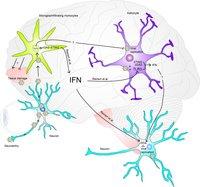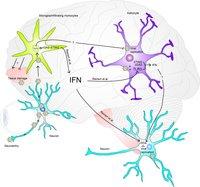
Credit: Line Reinert
Imagine seeing a building on fire. You grab the phone and call the fire service. What happens next can be compared to the discovery made by researchers from Aarhus University. They have discovered that a specific type of cell in the brain, microglia, acts as the incident commander in the defence against the invading virus, for example a herpes virus.
In cases of viral infection in the brain, this cell type coordinates reinforcements. It recruits additional microglia to the area, which in turn warns the neighbouring cells that something dangerous is happening. These cells are called astroglia and neurons.
After this, the 'fire' is put out, and 'medical help' is called in via proteins, so the cells that have been injured or killed can be removed.
"Viruses which travel via nerve cells into the brain are recognised by several types of cells, though not all cells are able to defend themselves against the infection. But microglia can, and through an alarm system (cGAS/STING), they are able to initiate a very strong immune reaction and suppress the virus," explains one of the researchers behind the discovery, Line Reinert from the Department of Biomedicine at Aarhus University.
The results have just been published in Nature Communications, and on the basis of the new knowledge the researchers hope to be able to contribute to new and better treatment of brain diseases such as multiple sclerosis, Alzheimer's disease and potentially also psychiatric disorders.
"We have identified and described a communication network that begins in the brain, when the cGAS/STING alarm system is activated. This new knowledge can potentially be utilised to prevent other types of diseases of the brain, where the same alarm system is either not activated or is activated too much," says Line Reinert.
The next step is to look at how damage to the brain occurs during infections and other diseases, and examine which mechanisms the brain uses to find the balance between the good and harmful aspects of the immune system.
"The brain is an organ which cannot withstand much damage. So it must therefore have, on the one hand, defence mechanisms against infections and, on the other hand, not utilise these too strongly. If microglia are activated too much, they do not only suppress the virus, but also damage some of the brain tissue. We are now working to understand this," says Søren Riis Paludan, who has led the project group, which has also involved other research groups from Denmark and abroad.
###
The research results – more information
Type of study: Basic research
Partners: Researchers from Aarhus University, The University of Southern Denmark and The University of Massachusetts
External funding: The Lundbeck Foundation, The Danish Council for Independent Research
Read the scientific article: Sensing of HSV-1 by the cGAS-STING pathway in microglia orchestrates antiviral defence in the CNS
Media Contact
Line Reinert
[email protected]
45-87-16-72-69
@aarhusuni
http://www.au.dk
############
Story Source: Materials provided by Scienmag





